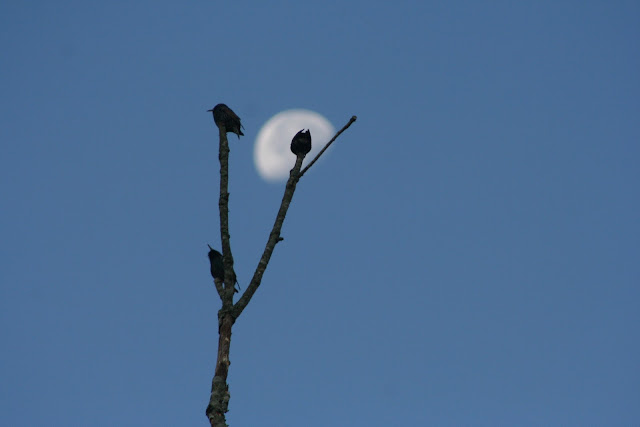For years, Julie, Jay, Hunter and I have shared a love of nature and the outdoors unrivaled by nearly any other family we know. Regardless of our destination or the overt purpose of our travels, chances are we'll gravitate toward the fringes to commune for a few moments with the natural world. It's always been gratifying to know we're "birds of a feather" in that regard. With Julie's expertise in biology and chemistry, and my habit of keeping one eye on the woods at all times (except when I'm driving, of course - Of course!), even a brief errand across town holds the potential for a meaningful encounter with nature.
 |
| Great Egret hunting in roadside canal. Hyde County, NC |
So when our travel plans involve greater distances, the opportunities for encounters with nature increase in proportion with the distance traveled. Yesterday we headed "Down East" to Little Washington for a visit with Julie's grandmother. As luck would have it, Julie's parents were also there, so we had a wonderful visit, during which Julie's dad shared several great stories of his experiences surveying a vast tract of land in Hyde County, North Carolina, near Lake Mattamuskeet.
 |
| Great Egret, plumes afurl in a chilly wind |
Lake Mattamuskeet is legendary for its critical place along the North American Mid-Atlantic flyway for wintering waterfowl, and here we were, not more than 70 miles away. Vast distances, even with good highways, require time to travel, so we knew we'd have relatively little time at the lake before dark, but we decided to make the trek anyway.
 |
| Double-crested Cormorant cruising the shallows of Mattamuskeet |
Recognizing the hazards in allowing his swivel-necked dad behind the wheel on narrow roads flanked by 14 foot drainage canals on either side, Jay, newly licensed to drive in NC, graciously agreed to drive. Four bald eagles and innumerable old white farmhouses later, we had passed through Yeatesville, Pantego, Belhaven and Swan Quarter and arrived in the vicinity of Mattamuskeet.
 |
| Belted Kingfisher hiding from view along the shore of Mattamuskeet |
Hunter diligently maintained a list of some thirty bird species we encountered along the way, but lists went by the wayside during a magical 30 minutes at sunset on the shores of the lake itself. As Jay turned onto a narrow dirt lane leading to the offices of the Lake Mattamuskeet National Wildlife Refuge, we were left speechless by the beauty of this place and its inhabitants. Herons, egrets, coots, cormorants, kingfishers and geese in a single sweeping glance. Ducks we could not name settled onto the lake's golden surface, and small perching birds we didn't recognize called from the reeds and shrubs.
 |
| American coots excited by our arrival |
 |
A song without words.
 |
As night fell, Dad remembered that he had hoped to see tundra swans.
 |
The swans obliged.
Feeding quietly in the shelter of the dike.
Oblivious to the watchers.
Mattamuskeet moments...











































